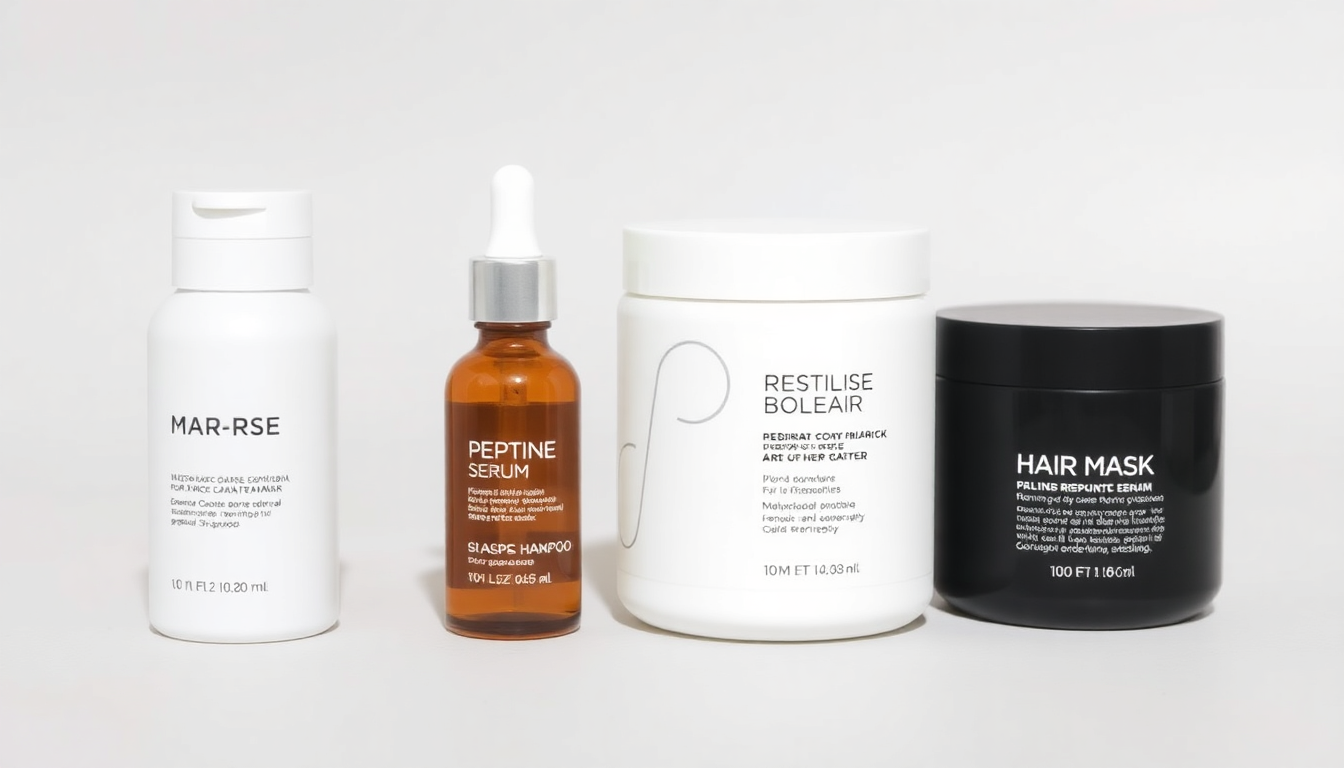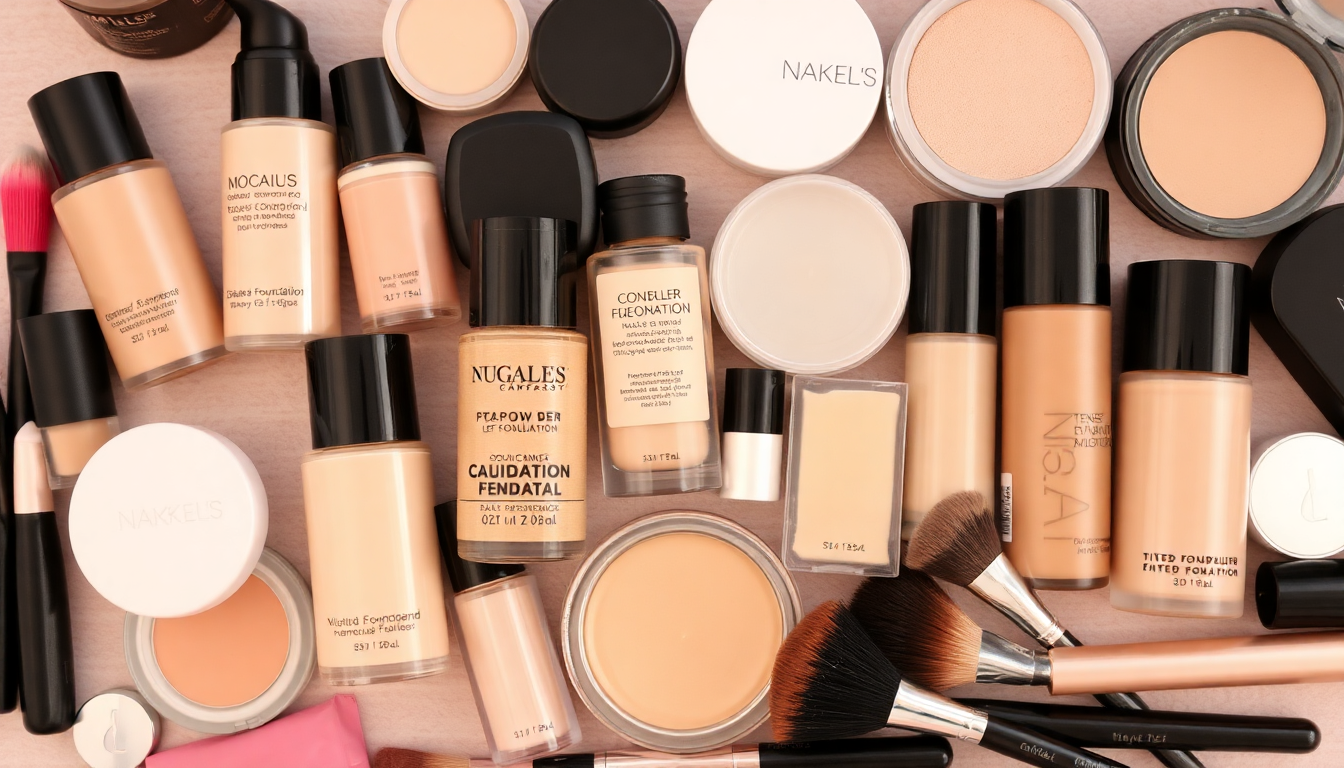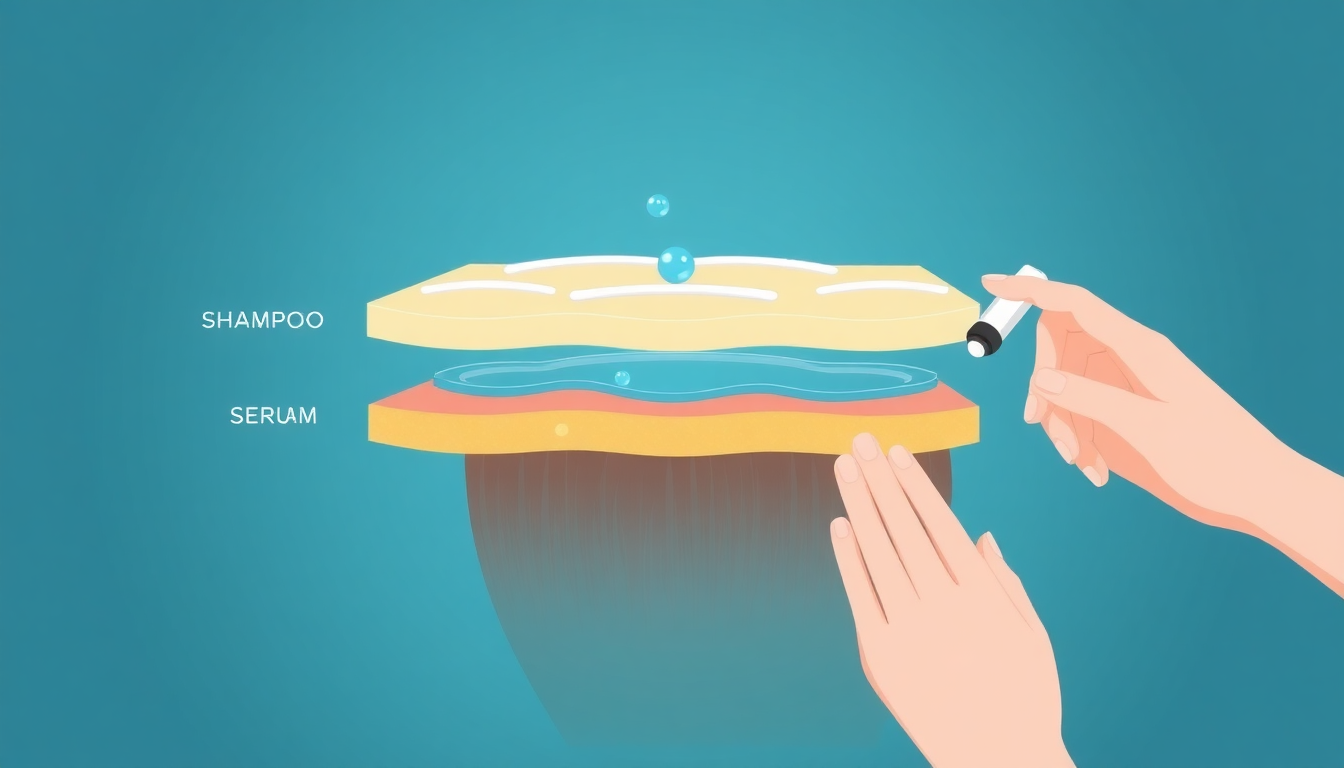Introduction: A minimalist approach that actually repairs
In 2025, the trend toward fewer, better products has matured into an evidence-based approach: a minimalist hair repair routine can deliver measurable strength gains when it focuses on three pillars — the right shampoo, a targeted peptide serum, and a weekly intensive mask. This article expands on the how and why, compares product types, explains ingredients, and gives a start-to-finish routine with variations for different hair types. Throughout, you'll find practical tips, troubleshooting, and clear shopping guidance to choose products that deliver results.
How hair is built and how it breaks: the science in plain language
- The cuticle: The outer layered scales that protect the hair fiber. Raised or damaged cuticles cause porosity, dullness, and friction.
- The cortex: The structural core containing keratin protein and elastic fibers. Breaks in cortex integrity lead to weakness and breakage.
- Disulfide bonds: Chemical links between keratin molecules that give hair strength. Chemical services and heat can sever these bonds.
- Lipid layer/CMC (cell membrane complex): The lipid matrix between cuticle cells that keeps moisture balance and smoothness. Stripping detergents and hard water remove lipids.
Effective repair strategies target the cuticle (seal and smooth), cortex (rebuild structure with protein and bond-repair technology), and lipids (restore moisture and slip).
Key ingredient categories explained
Understanding ingredient categories helps you choose products that work together rather than fighting each other.
- Bond-repair actives: Ingredients like bis-aminopropyl diglycol dimaleate, cysteine derivatives, and certain polymers claim to reconnect or compensate for broken disulfide bonds. Use bond-repair shampoos and treatments on chemically treated or severely damaged hair.
- Peptides & hydrolyzed proteins: Short chains of amino acids or protein fragments that can partially penetrate or adhere to the hair surface to improve tensile strength and elasticity. They complement but don’t fully replace deep protein treatments.
- Humectants: Glycerin, propanediol, panthenol and hyaluronic acid attract water to the hair, improving flexibility and reducing breakage from dryness.
- Emollients & oils: Fatty alcohols, esters, and lightweight oils (squalane, caprylic/capric triglyceride) restore the lipid layer and reduce friction. Use them in masks and leave-ins.
- Silicones: Dimethicone or cyclomethicone provide temporary smoothing and slip to reduce breakage during combing. Choose rinse-out silicones or water-soluble versions if you prefer easier removal.
- Surfactants: Sodium lauryl sulfate (SLS) and similar strong detergents cleanse aggressively but can over-strip; milder alternatives (sodium cocoyl isethionate, sodium lauroyl sarcosinate, decyl glucoside) are gentler on damaged hair.
Comparing shampoos: which category should you pick?
Not all shampoos are created equal when repairing hair. Here’s how to choose based on damage and lifestyle.
- Bond-building shampoos: Best for chemically damaged or bleached hair. These contain actives that either rebuild or mimic the effect of disulfide bonds. Replace your primary shampoo with a bond-building option if your hair has been through significant chemical alteration.
- Sulfate-free moisturizing shampoos: Ideal for color-treated, porous, or dry hair. They cleanse without removing natural oils and help maintain the lipid layer.
- Protein-enriched shampoos: Good for very porous hair that needs structure, but use sparingly to avoid protein overload.
- Clarifying shampoos: Use 1x per 2–4 weeks to remove buildup (hard water minerals, silicones, heavy oils). Not for regular use on repaired hair.
- Co-washes & conditioning cleansers: For very dry or curly hair, co-washes reduce stripping and preserve moisture during frequent cleansing.
Example image: 
Peptide serums: what they do, how to use them, and what to look for
Peptide serums take a leading role in a minimalist routine because they deliver continuous, leave-on repair signals and surface strengthening without adding many steps.
- Mechanism: Peptides can bond to the hair surface, fill micro-gaps in the cuticle, and support keratin alignment. They improve combability, reduce split ends appearance, and enhance elasticity.
- Format: Lightweight serums, sprays, or leave-in creams—serums are preferred for minimalism because they absorb quickly and layer well under styling products.
- What to look for: Clearly named peptides (e.g., palmitoyl tripeptide, hydrolyzed keratin peptides), supporting humectants (glycerin, panthenol), and a non-greasy delivery vehicle.
Example image: 
Weekly masks: protocols, choices, and DIY safe recipes
Weekly masks are the concentrated step in the minimalist routine. They correct deficits and give visible conditioning results.
- How to choose: If hair stretches excessively when wet and snaps, start with a protein or hybrid mask. If hair is dry, coarse, and frizzy, prioritize moisture masks.
- Application tips: Apply to mid-lengths and ends (avoid heavy application at the scalp unless the product is formulated for scalp use). Cover with a shower cap and apply gentle heat (warm towel or blow dryer on low) for deeper penetration.
- Frequency: Most people will use a hybrid or moisture mask weekly and alternate with a protein mask every 2–4 weeks. Adjust frequency based on response.
DIY hybrid mask (simple and safe): mix 1 tbsp plain yogurt (protein), 1 tsp honey (humectant), and 1 tsp argan oil (emollient). Apply for 20 minutes, then rinse and shampoo as usual. Note: DIYs are supplementary and may not replace targeted, lab-formulated intensive masks.
Example image: 
Full minimalist routine: daily, weekly, and monthly schedules
This is a practical calendar you can adapt.
- Daily (if you wash every day): gentle sulfate-free cleansing; light peptide serum on damp hair; leave-in heat protectant if styling.
- 2–3x weekly: Primary shampoo (bond-building or moisturizing depending on needs); conditioner or light rinse-out mask after; apply peptide serum after towel-drying.
- Weekly: Deep hybrid or moisture mask; optionally follow with a peptide serum for overnight leave-on benefit on damp hair.
- Every 2–4 weeks: Protein mask or bond-repair intensive treatment; clarifying wash if product build-up or hard water is an issue.
- Ongoing maintenance: Trim split ends every 6–12 weeks; protect hair from UV exposure; minimize daily heat and tight styles.
Routine examples for specific hair types and goals
- Fine, chemically damaged hair: Bond-building shampoo 2x weekly, light hybrid mask weekly, peptide hair serum daily on damp hair. Use minimal oil to avoid weighing hair down. Recommended product: Eelhoe bond-building shampoo and Eelhoe peptide hair serum.
- Curly, porous hair: Co-wash between washes, moisture-rich mask weekly, protein mask every 3–4 weeks, heavy-duty leave-in with peptides and oils for definition and slip.
- Bleached or color-treated hair: Bond-building shampoo as primary cleanser, alternate protein and moisture masks, daily peptide serum to reduce porosity and protect color fade.
- Thick, coarse hair: Rich hybrid mask weekly, moisturizing shampoo 1–2x weekly, generous leave-in peptide serum and smoothing oil for ends.
Tools and techniques that reduce breakage
- Detangle hair in the shower with conditioner using a wide-tooth comb.
- Use microfiber towels or cotton T-shirts to compress rather than rub when drying.
- Choose paddle brushes with flexible bristles for straight hair and wide-tooth combs for curly hair.
- Heat styling: use a good heat protectant, keep tools at the lowest effective temperature, and avoid repeated passes.
- Nightcare: sleep on a silk pillowcase or use a silk/satin scarf to reduce friction.
How to read labels: practical tips
Labels can be confusing. Here are quick heuristics:
- Ingredients lists are ordered by concentration — early positioning indicates higher amounts.
- Look for named bond-repair ingredients or peptides by name rather than vague 'proprietary complex' claims.
- Avoid products where harsh sulfates (SLS, SLES) are among the top 3 ingredients if hair is damaged or colored.
- Understand marketing terms: 'repair' and 'strengthening' can be cosmetic (coating) or active (bond rebuilding). Check the ingredient list to confirm.
Troubleshooting: what to do when your repair routine stalls
- Hair feels stiff or brittle: You may be overdoing protein. Reduce protein masks, increase moisturizing treatments, and add more emollients.
- Hair still breaks at the same length: Address mechanical damage (tight styles, rough brushing) and ensure heat protection; consider professional bond-repair salon services if home care stalls.
- Oily roots with dry ends: Use lighter products at the scalp, apply masks primarily to mid-lengths and ends, and consider a clarifying wash once per month.
- No visible improvement after 8–12 weeks: Reassess product efficacy — choose clinically-backed bond-repair products and consider consulting a professional trichologist.
Measuring progress: simple tests and metrics
- Elasticity test: Take a single wet strand and stretch gently — healthy hair stretches and snaps back. Reduced stretch or snapping indicates need for protein/hydration balance changes.
- Porosity test: Place a clean strand in water — sinking quickly indicates high porosity. Adjust mask strategy accordingly.
- Breakage tracking: Photograph lengths monthly and note reduced shedding or fewer short broken pieces over time.
Realistic timeline: what to expect and when
Hair regrowth and full structural repair are gradual. Expect cosmetic improvements (shine, slip, combability) within 2–6 weeks. Strength and measurable reduction in breakage typically require 8–16 weeks of consistent care. Severely damaged hair may also need strategic trims to remove compromised lengths before true improvement is visible.
Product recommendations and shopping guide (minimalist three-step system)
To simplify your search, a three-product system (shampoo, peptide serum, intensive mask) is effective. For targeted repair, consider products formulated to work together:
- Bond-building shampoo — for chemically damaged hair: try formulations with bond-repair actives and mild surfactants. Example: Eelhoe bond-building shampoo is formulated to cleanse gently while supporting disulfide bond integrity.
- Peptide hair serum (leave-in) — daily strengthening and protection: choose a lightweight peptide serum with humectants. Example: Eelhoe peptide hair serum provides continuous surface reinforcement and slip for combing.
- Intensive hair mask — weekly concentrated repair: a hybrid mask with both protein and moisture delivers balanced results. Example: Eelhoe intensive hair mask is formulated for restoring elasticity and smoothing cuticles.
Product imagery: 
Cost-efficiency and sustainability: why fewer products win
A minimalist routine reduces clutter, saves money, and can be more sustainable. Buying fewer multi-functional, high-quality products typically reduces packaging waste and simplifies your regimen so you’re consistent — consistency is the main driver of repair.
Case study: Typical 12-week repair timeline
Client A — bleached, porous, mid-length breakage:
- Weeks 0–2: Introduced bond-building shampoo 2x weekly and a peptide serum daily. Immediate improvement in combability.
- Weeks 3–6: Started weekly hybrid mask and reduced heat styling. Reduced short-breakage counts and improved shine.
- Weeks 7–12: Alternated protein masks every 3 weeks, strong visible improvement in elasticity tests and fewer split ends; scheduled a trim at week 12 to remove remaining damaged lengths.
Extended FAQ
- Can I layer peptide serum under oil? Yes — apply peptides to damp hair, let absorb, then add a small amount of oil to the ends if needed for seal and shine.
- Are bond-building products safe for color-treated hair? Generally yes — bond-building shampoos are formulated to protect both bonds and color. Always check product claims for color-safe labeling.
- Will peptide serums make my scalp oily? Most peptide serums are formulated for mid-lengths and ends and are lightweight; avoid applying heavy serums directly to the scalp if oiliness is a concern.
Final checklist before you buy
- Identify your primary hair issue (porosity, dryness, breakage, color damage).
- Choose a bond-building or sulfate-free shampoo accordingly.
- Pick a peptide serum with clear peptide ingredients and humectants.
- Select a hybrid intensive mask for weekly application, with occasional protein-only treatments if needed.
- Start slowly — follow product directions and track changes every 4 weeks.
Conclusion: Start a simple, science-backed repair routine today
Minimalism in hair care isn't about using fewer products for the sake of it — it's about choosing fewer, more effective, science-backed products and using them consistently. A targeted bond-building shampoo, a peptide hair serum, and a weekly intensive mask form a powerful trio that restores hair strength, reduces breakage, and improves manageability.
Ready to start? Explore a curated three-step repair system designed to work together: Eelhoe bond-building shampoo, Eelhoe peptide hair serum, and the Eelhoe intensive hair mask. These products are formulated to complement each other and simplify your path to restored strength.
Sponsored link: visit Eelhoe Cosmetics to shop the repair trio and start your minimalist hair repair routine today.
Illustrations & image credits
-
 — bond-building shampoo product image.
— bond-building shampoo product image. -
 — peptide serum product image.
— peptide serum product image. -
 — intensive hair mask product image.
— intensive hair mask product image.
Need a tailored plan?
If you want a personalized minimalist routine (product picks and a 12-week timeline based on your hair type and history), leave a comment or reach out to customer support at Eelhoe Cosmetics for product recommendations and guidance.




Laat een reactie achter
Alle reacties worden gemodereerd voordat ze worden gepubliceerd.
Deze site wordt beschermd door hCaptcha en het privacybeleid en de servicevoorwaarden van hCaptcha zijn van toepassing.